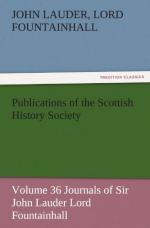MONEY
Lauder mentions a great variety of coins both in his Journal in France and in his Accounts after his return home. Some explanation of the principal coins may be useful. It is necessary to keep in mind that the value of coins was in a perpetual flux. There were during the century frequent changes in the value of coins relatively even to those of the same country.
1. In France.
(1) Livre. The livre used by Lauder, and called by him indifferently ‘frank,’ was the livre tournois,[28] of 20 sous. It was, subject to exchange, of the same value as the pound Scots,[29] 1s. 8d. sterling, which greatly simplifies calculations. The L s. d. French was equal to the L s. d. Scots, and one twelfth of the value of the L s. d. English or sterling.
[28] The livre parisis contained
25 sous.—Major’s Greater
Britain
(S.H.S.), p. 32, note.
[29] See pp. 3 and 4 and passim.
(2) Ecu, ecu blanc, or d’argent, a silver coin worth 3 livres,[30] or 5s. sterling, thus of the same value as the English crown, and sometimes called crown by Lauder.
[30] The value varied a little,
but it was three livres in 1653.—
Memoires
de l’Academie des Inscriptions et de Belles Lettres
(1857),
Tome 21, 2’me partie, p. 350.
(3) Ecu d’or, or couronne, golden crown. It was worth about 5 livres 12 sous,[31] equal to 9s. 4d. sterling. (P. 155, ’I receaved some 56 ll. in 10 golden crowns.’)
[31] The exact value in 1666
in livres tournois was 5 ll. 11s. 6d.—
Memoires,
ut supra, p. 256.
(4) Pistole. A Spanish gold coin current in France. Its standard value was 10 livres tournois, equal to 16s. 8d. That fairly corresponds with a proclamation in Ireland in 1661 fixing it at 16s. Littre (Dict. s.v.), states the value of the coin a good deal higher, though he gives the standard as above. But its value gradually increased, like that of other gold coins, and in later Irish proclamations is much higher.
The British gold coins Jacobus and Carolus were also used by Lauder in France, and are explained below.




